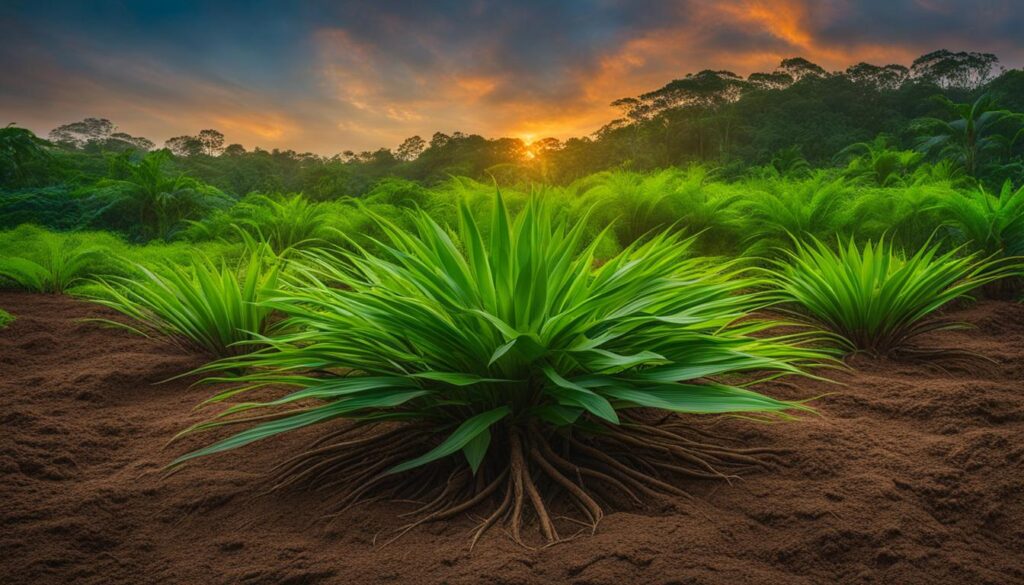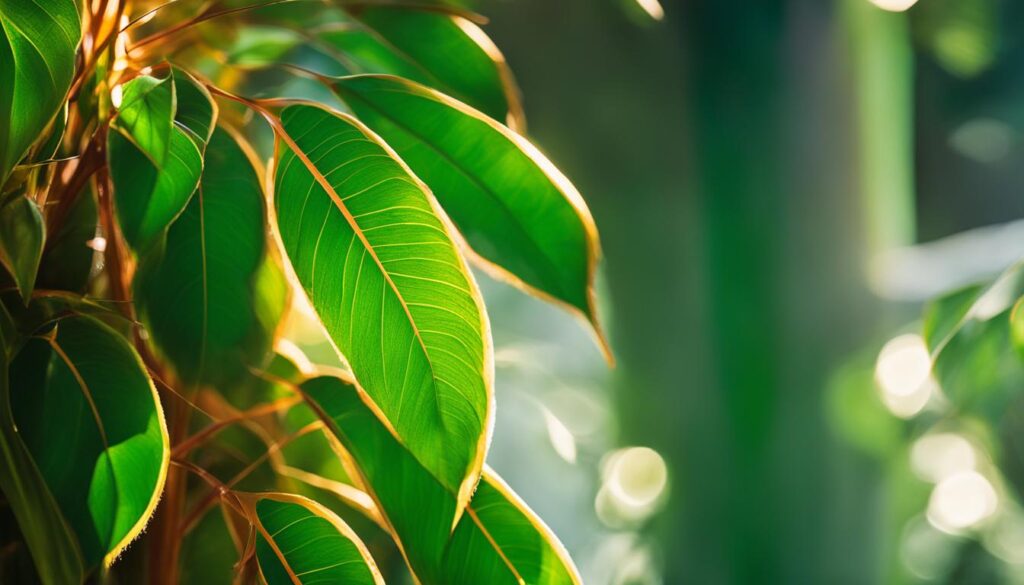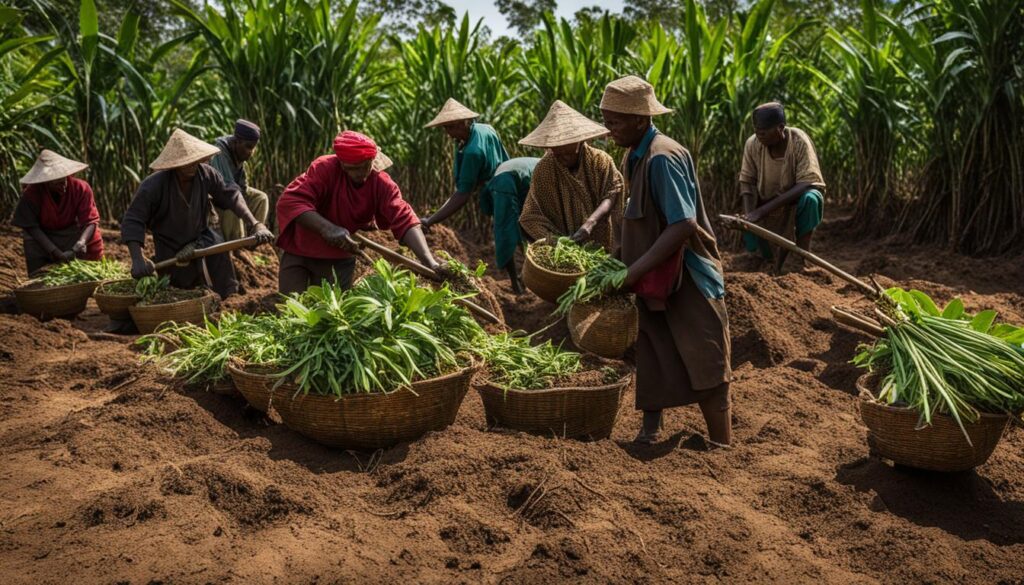Tongkat Ali, also known as Longjack, is a potent herb that has gained popularity in the holistic health community. It has been used for centuries and is believed to have various health benefits. However, proper care is essential for the plant to thrive and produce a healthy harvest. In this section, I will provide you with tips and guidelines for growing and maintaining Tongkat Ali plants in your home or garden.
Key Takeaways:
- Choose a sunny location with well-drained soil for planting Tongkat Ali.
- Water the plant regularly, but avoid overwatering to prevent root rot.
- Prune the plant in late winter or early spring to promote healthy growth.
- Inspect the plant for pests and diseases, and treat them accordingly.
- Harvest the roots carefully after the plant reaches at least 5 years of age.
Planting and Soil Conditions for Tongkat Ali
Tongkat Ali plants require specific planting and soil conditions in order to thrive and produce a healthy harvest. Here are some important tips to keep in mind:
- Choose a sunny location: Tongkat Ali plants need at least 6 hours of direct sunlight each day. Select a spot in your garden or yard that receives ample sunlight.
- Well-drained soil: The soil should be well-drained, with a pH level between 6 and 7. If your soil is heavy or clay-like, consider adding organic matter or compost to improve drainage.
- Preparing the planting hole: Dig a hole slightly larger than the root ball of the Tongkat Ali plant. Backfill the hole with a mixture of compost and soil.
- Watering after planting: After planting, water the plant thoroughly to help settle the soil and ensure good root establishment.
- Moist, not waterlogged: Keep the soil moist but avoid waterlogging. Regularly check the soil moisture and adjust watering accordingly.
By following these guidelines, you can provide the optimal planting and soil conditions for your Tongkat Ali plants, setting them up for healthy growth and a bountiful harvest.

Table: Tongkat Ali Planting and Soil Conditions
| Planting Condition | Tips |
|---|---|
| Sunlight | Select a sunny location with at least 6 hours of direct sunlight each day. |
| Soil | Use well-drained soil with a pH level between 6 and 7. Improve drainage if necessary. |
| Planting Hole | Dig a hole slightly larger than the root ball. Backfill with a mixture of compost and soil. |
| Watering | Water thoroughly after planting. Keep the soil moist but not waterlogged. |
Watering and Sunlight Requirements for Tongkat Ali
Proper watering and adequate sunlight are essential for the health and growth of Tongkat Ali plants. Understanding the specific requirements of these factors will help you ensure the optimal conditions for your plants.
Watering:
Tongkat Ali plants require regular watering to thrive, but it’s important to avoid overwatering. Overwatering can lead to root rot and other issues that can harm the plant. The frequency of watering will depend on various factors, including climate and soil conditions.
As a general guideline, it is recommended to water the plant when the top inch of soil feels dry to the touch. This indicates that the plant is in need of water. Use a watering can or a gentle spray from a hose to evenly moisten the soil around the plant.
Sunlight Requirements:
Tongkat Ali plants thrive in bright, direct sunlight. It is important to provide them with at least 6 hours of direct sunlight each day. Choose a sunny location in your garden or place your plants near a south-facing window if growing indoors.
If you are growing Tongkat Ali plants outdoors, make sure they are not shaded by trees or other structures that can block sunlight. Indoor growers can use artificial grow lights to supplement natural sunlight and ensure the plants receive adequate light.

Table: Watering and Sunlight Requirements
| Watering Requirements | Sunlight Requirements |
|---|---|
| Regular watering to keep soil moist but not waterlogged | At least 6 hours of direct sunlight each day |
| Water when top inch of soil feels dry to the touch | Grown outdoors: Avoid shading from trees or structures |
| Avoid overwatering to prevent root rot | Grown indoors: Use artificial grow lights if necessary |
By following these guidelines for watering and sunlight requirements, you can provide optimal conditions for your Tongkat Ali plants. Remember to monitor the moisture levels of the soil and adjust watering accordingly. Additionally, ensure that your plants receive adequate sunlight to support healthy growth. With proper care, your Tongkat Ali plants will thrive and provide you with a bountiful harvest.
Pruning and Fertilization of Tongkat Ali Plants
Pruning plays a crucial role in maintaining the overall health and vigor of Tongkat Ali plants. Regular pruning helps stimulate new growth, maintain the desired shape, and prevent the plant from becoming too dense. It is recommended to prune the plants in late winter or early spring, before the onset of new growth.
When pruning Tongkat Ali plants, start by removing any dead or damaged branches. These branches not only detract from the plant’s appearance but can also attract pests and diseases. Use clean pruning shears or gardening scissors to make clean cuts at a slight angle just above a healthy bud or lateral branch.
In addition to pruning, proper fertilization is essential for the optimal growth and development of Tongkat Ali plants. Start by applying a balanced slow-release fertilizer during the growing season, following the instructions provided by the manufacturer. This will ensure that the plants receive a steady supply of essential nutrients over an extended period.
It is important to note that Tongkat Ali plants are sensitive to excessive fertilization. Overfertilization can lead to imbalances in nutrient uptake and may result in stunted growth or burning of the foliage. Therefore, it is crucial to closely monitor the plants and adjust the fertilization regimen accordingly. If in doubt, it is always recommended to consult a gardening expert for personalized advice.
Pruning and Fertilization Tips for Tongkat Ali Plants
- Prune Tongkat Ali plants in late winter or early spring, before new growth appears.
- Remove any dead or damaged branches to maintain plant health and prevent pest infestations.
- Use clean pruning shears or gardening scissors to make clean cuts just above healthy buds or lateral branches.
- Apply a balanced slow-release fertilizer during the growing season, following the manufacturer’s instructions.
- Monitor the plants closely to avoid overfertilization, which can lead to stunted growth or foliage burn.
- Seek expert advice if unsure about the proper pruning and fertilization practices for Tongkat Ali plants.
By incorporating regular pruning and appropriate fertilization into your Tongkat Ali plant care routine, you can ensure the plants thrive and achieve optimal growth and health. Remember to prune the plants at the right time of year, removing any dead or damaged branches, and apply fertilizers in moderation to promote vigorous growth without causing harm. With proper care, your Tongkat Ali plants will reward you with a bountiful harvest of this powerful herb.
Pests and Diseases of Tongkat Ali Plants
Tongkat Ali plants are generally hardy and resistant to pests and diseases, but there are still some issues that can affect their health. Here are some common pests and diseases that you should watch out for when caring for your Tongkat Ali plants:
Aphids
Aphids are small, soft-bodied insects that feed on the sap of plants. They can cause damage to the leaves and stems of Tongkat Ali plants, leading to stunted growth and yellowing of the foliage. To control aphids, you can try spraying the plants with a mixture of water and mild dish soap, or introduce natural predators like ladybugs to your garden.
Spider Mites
Spider mites are tiny pests that often go unnoticed until their population explodes. They suck the sap from the leaves, causing small yellow or white spots and webbing on the foliage. To get rid of spider mites, you can spray the plants with a mixture of water and neem oil, or use insecticidal soap. It’s important to treat the plants early to prevent the infestation from spreading.
Mealybugs
Mealybugs are small, soft-bodied insects that feed on the sap of plants, similar to aphids. They can be identified by their white, waxy appearance. Mealybugs can cause damage to the leaves and stems of Tongkat Ali plants and can also attract ants. You can try removing mealybugs by gently wiping them off with a cotton swab dipped in rubbing alcohol. If the infestation is severe, you may need to use insecticidal soap.
| Pests | Diseases |
|---|---|
| Aphids | Root Rot |
| Spider Mites | Leaf Spot |
| Mealybugs | Powdery Mildew |
It’s important to regularly inspect your Tongkat Ali plants for any signs of pests or diseases and take appropriate action to prevent their spread. Remember to maintain a healthy growing environment by providing adequate sunlight, proper watering, and regular pruning. With proper care, your Tongkat Ali plants can thrive and provide you with a bountiful harvest of this powerful herb.
Harvesting and Storage of Tongkat Ali
Harvesting Tongkat Ali is a meticulous process that requires patience and careful attention to detail. The roots, which contain the potent bioactive compounds, are typically harvested after the plant reaches at least 5 years of age. It is important to dig out the long, twisted roots carefully to avoid damaging them. Once the roots are extracted from the ground, they can be cleaned to remove any soil or debris. The outer layer of the root can then be peeled to reveal the inner core, which is the part of the plant that is used for medicinal purposes.
After harvesting Tongkat Ali, proper storage is essential to preserve its potency and efficacy. The roots should be dried thoroughly to prevent mold or decay. This can be done by placing the roots in a well-ventilated area with low humidity. It may take several weeks for the roots to dry completely. Once dried, the roots can be stored in airtight containers to protect them from moisture, light, and air. It is recommended to store the roots in a cool, dark place, such as a pantry or a cellar. This will help maintain their quality and potency for an extended period.

When it comes to consuming Tongkat Ali, it is important to consult with a healthcare professional or herbalist to determine the appropriate dosage and usage. Tongkat Ali can be consumed in various forms, such as capsules, extracts, or teas. It is important to follow the instructions provided and not exceed the recommended dosage. As with any herbal supplement, it is important to be mindful of potential side effects or interactions with other medications or health conditions.
Benefits of Harvesting Your Own Tongkat Ali
Harvesting your own Tongkat Ali can be a rewarding experience, as it allows you to have full control over the quality and source of the herb. By growing and harvesting the plant yourself, you can ensure that it is free from pesticides, chemicals, or other contaminants that may be present in commercially available products. Additionally, by properly storing the harvested roots, you can have a steady supply of Tongkat Ali for personal use or even for sharing with others who may benefit from its medicinal properties.
| Benefits of Harvesting Your Own Tongkat Ali: |
|---|
| Control over quality and source of the herb |
| Avoidance of pesticides and contaminants |
| Steady supply for personal use or sharing |
Conclusion
In conclusion, maintaining Tongkat Ali plants requires careful attention and proper care. By following the tips and guidelines provided in this article, you can ensure that your plants thrive and produce a healthy harvest of this potent herb.
Remember to provide the right growing conditions, including well-drained soil and sufficient sunlight. Regularly check the soil moisture and water the plants as needed, avoiding overwatering to prevent root rot.
Pruning the plants in late winter or early spring helps promote healthy growth and maintains the desired shape. Be vigilant for any signs of pests and diseases, and treat them promptly with appropriate measures to protect your Tongkat Ali plants.
Lastly, when it comes time to harvest, do so with care to preserve the long, twisted roots that contain the valuable bioactive compounds. Properly store the harvested Tongkat Ali for long-term use, ensuring its potency for future consumption.
